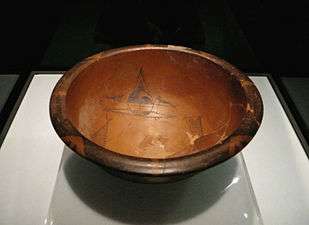Yangshao culture
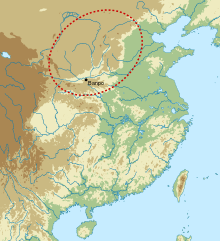 | |||||||
| Geographical range | Loess Plateau | ||||||
|---|---|---|---|---|---|---|---|
| Period | Neolithic | ||||||
| Dates | c. 5000 – c. 3000 BC | ||||||
| Major sites | Banpo, Jiangzhai | ||||||
| Preceded by | Peiligang culture, Dadiwan culture, Cishan culture | ||||||
| Followed by | Longshan culture | ||||||
| Chinese name | |||||||
| Chinese | 仰韶文化 | ||||||
| |||||||
The Yangshao culture was a Neolithic culture that existed extensively along the Yellow River in China. It is dated from around 5000 BC to 3000 BC. The culture is named after Yangshao, the first excavated site of this culture, which was discovered in 1921 in Mianchi County, Henan Province by the Swedish geologist Johan Gunnar Andersson (1874–1960).[1] The culture flourished mainly in the provinces of Henan, Shaanxi and Shanxi.
Economy
Subsistence
The main food of the Yangshao people was millet, with some sites using foxtail millet and others broom-corn millet, though some evidence of rice has been found. The exact nature of Yangshao agriculture, small-scale slash-and-burn cultivation versus intensive agriculture in permanent fields, is currently a matter of debate. Once the soil was exhausted, residents picked up their belongings, moved to new lands, and constructed new villages.[2] However, Middle Yangshao settlements such as Jiangzhi contain raised-floor buildings that may have been used for the storage of surplus grains. Grinding stones for making flour were also found.[3]
The Yangshao people kept pigs and dogs. Sheep, goats, and cattle are found much more rarely.[4] Much of their meat came from hunting and fishing.[3] Their stone tools were polished and highly specialized. They may also have practiced an early form of silkworm cultivation.[4]
Crafts
The Yangshao culture crafted pottery. Yangshao artisans created fine white, red, and black painted pottery with human facial, animal, and geometric designs. Unlike the later Longshan culture, the Yangshao culture did not use pottery wheels in pottery-making. Excavations found that children were buried in painted pottery jars.
The Yangshao culture produced silk to a small degree and wove hemp. Men wore loin cloths and tied their hair in a top knot. Women wrapped a length of cloth around themselves and tied their hair in a bun.
Houses
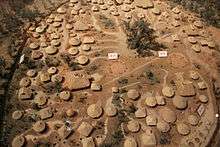
Houses were built by digging a rounded rectangular pit a few feet deep. Then they were rammed, and a lattice of wattle was woven over it. Then it was plastered with mud. The floor was also rammed down.
Next, a few short wattle poles would be placed around the top of the pit, and more wattle would be woven to it. It was plastered with mud, and a framework of poles would be placed to make a cone shape for the roof. Poles would be added to support the roof. It was then thatched with millet stalks. There was little furniture; a shallow fireplace in the middle with a stool, a bench along the wall, and a bed of cloth. Food and items were placed or hung against the walls. A pen would be built outside for animals.
Yangshao villages typically covered ten to fourteen acres and were composed of houses around a central square.[2]
Social structure
Although early reports suggested a matriarchal culture,[5] others argue that it was a society in transition from matriarchy to patriarchy, while still others believe it to have been patriarchal. The debate hinges on differing interpretations of burial practices.[6][7]
Archaeological sites
The Yangshao, Mianchi County, Sanmenxia City, Henan, the place which gave the culture its name, there is today a museum next to the site.[8] The archaeological site of Banpo village, near Xi'an, is one of the best-known ditch-enclosed settlements of the Yangshao culture. Another major settlement called Jiangzhai was excavated out to its limits, and archaeologists found that it was completely surrounded by a ring-ditch. Both Banpo and Jiangzhai also yielded incised marks on pottery which a few have interpreted as numerals or perhaps precursors to the Chinese script,[9] but such interpretations are not widely accepted.[10]
Phases
The Yangshao culture is conventionally divided into three phases:
- The early period (or Banpo phase, c. 5000–4000 BC) is represented by the Banpo, Jiangzhai, Beishouling and Dadiwan sites in the Wei River valley in Shaanxi.[11]
- The middle period (or Miaodigou phase, c. 4000–3500 BC) saw an expansion of the culture in all directions, and the development of hierarchies of settlements in some areas, such as western Henan.[12]
- The late period (c. 3500–3000 BC) saw a greater spread of settlement hierarchies. The first wall of rammed earth in China was built around the settlement of Xishan (25 ha) in central Henan (near modern Zhengzhou).[13]
The Majiayao culture (c. 3300–2000 BC) to the west is now considered a separate culture that developed from the middle Yangshao culture through an intermediate Shilingxia phase.[14]
Artifacts
- Ceramics
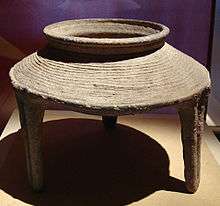 Ding, decorated with a string pattern
Ding, decorated with a string pattern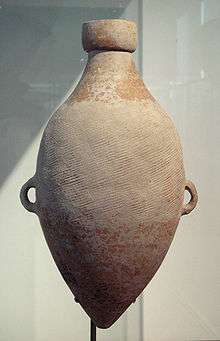 Cordmarked amphora; 4800 BC (Banpo phase); Guimet Museum (Paris)
Cordmarked amphora; 4800 BC (Banpo phase); Guimet Museum (Paris)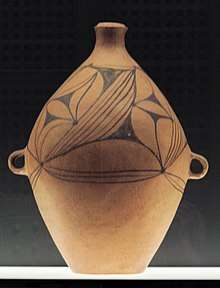 Large water vessel of the late Yangshao culture or early Majiayao; from Shaanxi, Shanxi or Gansu province; 4th millenium BC; Rietberg Museum (Zürich, Switzerland)
Large water vessel of the late Yangshao culture or early Majiayao; from Shaanxi, Shanxi or Gansu province; 4th millenium BC; Rietberg Museum (Zürich, Switzerland) Red amphira with carrying handles; circa 5000 - 3000 BC; Honolulu Museum of Art (USA)
Red amphira with carrying handles; circa 5000 - 3000 BC; Honolulu Museum of Art (USA)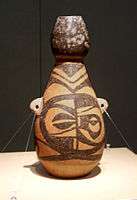 Pot; painted earthenware; in the Shijia style; Shaanxi History Museum
Pot; painted earthenware; in the Shijia style; Shaanxi History Museum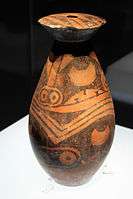 Pot; painted earthenware; height: 27.8 cm; in the Shijia style; Shaanxi History Museum
Pot; painted earthenware; height: 27.8 cm; in the Shijia style; Shaanxi History Museum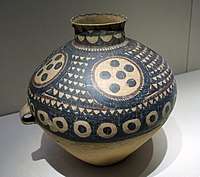 Dotted pottery pot, semi-mountain type; dating from 4700 to 4300 years; Gansu Provincial Museum
Dotted pottery pot, semi-mountain type; dating from 4700 to 4300 years; Gansu Provincial Museum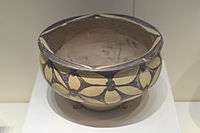 Painted pottery basin; 5000-3000 BC; National Museum of China
Painted pottery basin; 5000-3000 BC; National Museum of China
See also
| Wikimedia Commons has media related to Yangshao culture. |
References
- ↑ Yangshao Culture Museum
- 1 2 Pollard, Elizabeth (2015). Worlds Together Worlds Apart. W.W. Norton & Company. pp. 69–70. ISBN 978-0-393-91847-2.
- 1 2 Chang (1986), p. 112.
- 1 2 Chang (1986), p. 113.
- ↑ Roy, Kartik C.; Tisdell, C. A.; Blomqvist, Hans C. (1999). Economic development and women in the world community. Greenwood. p. 27. ISBN 978-0-275-96631-7.
- ↑ Linduff, Katheryn M.; Yan Sun (2004). Gender and Chinese Archaeology. AltaMira Press. pp. 16–19, 244. ISBN 978-0-7591-0409-9.
- ↑ Jiao, Tianlong (2001). "Gender Studies in Chinese Neolithic Archaeology". In Arnold, Bettina; Wicker, Nancy L. Gender and the Archaeology of Death. AltaMira Press. pp. 53–55. ISBN 978-0-7591-0137-1.
- ↑ 黄沛. "Yangshao Culture Museum". henan.chinadaily.com.cn. Retrieved 2018-04-13.
- ↑ Woon, Wee Lee (1987). Chinese Writing: Its Origin and Evolution. Joint Publishing, Hong Kong.
- ↑ Qiu Xigui (2000). Chinese Writing. Translation of 文字學概論 by Mattos and Jerry Norman. Early China Special Monograph Series No. 4. Berkeley: The Society for the Study of Early China and the Institute of East Asian Studies, University of California, Berkeley. ISBN 978-1-55729-071-7.
- ↑ Liu & Chen (2012), pp. 190–191.
- ↑ Liu & Chen (2012), pp. 191–193.
- ↑ Liu & Chen (2012), pp. 193–194.
- ↑ Liu & Chen (2012), p. 232.
- Chang, Kwang-chih (1986), The Archaeology of Ancient China (4th ed.), Yale University Press, ISBN 978-0-300-03782-1.
- Fiskesjö, Magnus; Chen, Xingcan (2004), China Before China: Johan Gunnar Andersson, Ding Wenjiang, and the Discovery of China's Prehistory, Stockholm: Museum of Far Eastern Antiquities, ISBN 978-91-970616-3-6.
- Li, Xinwei (2013), "The later Neolithic in the central Yellow River valley, c.4000–3000 BC", in Underhill, Anne P., A Companion to Chinese Archaeology, John Wiley & Sons, pp. 213–235, ISBN 978-1-118-32578-0.
- Liu, Li; Chen, Xingcan (2012), The Archaeology of China: From the Late Paleolithic to the Early Bronze Age, Cambridge University Press, ISBN 978-0-521-64310-8.
- Underhill, Anne P. (2002), Craft Production and Social Change in Northern China, Springer, ISBN 978-0-306-46771-4.
- Zhu, Yanping (2013), "The early Neolithic in the central Yellow River valley, c.7000–4000 BC", in Underhill, Anne P., A Companion to Chinese Archaeology, John Wiley & Sons, pp. 172–193, ISBN 978-1-118-32578-0.
